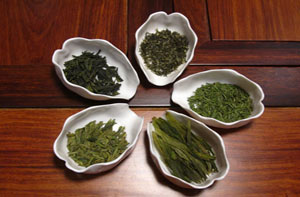Tea's slow start means better quality
2012-04-01 15:48:54
 A cold winter has delayed the marketing of Mingqian tea, the prime of Chinese green teas. But that is not entirely a bad thing, because the quality is expected to be higher.
A cold winter has delayed the marketing of Mingqian tea, the prime of Chinese green teas. But that is not entirely a bad thing, because the quality is expected to be higher.
Early tea chase
2012-04-01 13:36:24
 The first spring teas to reach the markets can fetch prices that have farmers singing all the way to the bank.
The first spring teas to reach the markets can fetch prices that have farmers singing all the way to the bank.
A center for food culture
2012-04-01 08:17:46
A Beijing institution long before US Vice-President Joe Biden wandered in, Yao's Chaogan restaurant fears the wrecking ball.
'Panda tea' steeped in controversy
2012-03-31 14:48:28
 Tea fertilized by the dung of giant pandas has provoked controversy in Southwest China's Sichuan province, with a local entrepreneur applying for a world record for the tea's whopping price tag.
Tea fertilized by the dung of giant pandas has provoked controversy in Southwest China's Sichuan province, with a local entrepreneur applying for a world record for the tea's whopping price tag.
Food poisoning incidents hit rural schools
2012-03-31 10:23:22
 Seven students at a primary school in Southwest China remain in the hospital after they had eaten a free meal provided by the government and got sick, according to a local official.
Seven students at a primary school in Southwest China remain in the hospital after they had eaten a free meal provided by the government and got sick, according to a local official.
The history of Longjing and Biluochun
2012-03-31 10:21:55
Longjing (dragon well) tea got famous as early as in the Ming Dynasty (1368-1644).
Brewing Mingqian tea
2012-03-31 10:21:25
To brew the super tender Mingqian teas, use water of lower temperature compared to normal teas—80 degrees Celsius for Longjing, and 70 degrees Celsius for Biluochun.
Sichuan cuisine
2012-03-27 17:00:23
Of the eight major schools of China's culinary art, Sichuan cuisine is perhaps the most popular.
Ding Baozhen's Kung Pao chicken
2012-03-27 15:27:09
 The origin of kung pao chicken (diced chicken fried with chili and peanuts) is generally believed to be related with Ding Baozhen.
The origin of kung pao chicken (diced chicken fried with chili and peanuts) is generally believed to be related with Ding Baozhen.
Story of fish-flavored pork
2012-03-27 15:18:43
 It is said that a long time ago, a businessman's family liked to eat fish. They paid close attention to flavors so they usually added onions, ginger, garlic, wine, vinegar and soy sauce when they cooked fish.
It is said that a long time ago, a businessman's family liked to eat fish. They paid close attention to flavors so they usually added onions, ginger, garlic, wine, vinegar and soy sauce when they cooked fish.

